Simulation Analysis on the Heat Performance of Deep Borehole Heat Exchangers in Medium-Depth Geothermal Heat Pump Systems
Abstract
:1. Introduction
2. Methodology
2.1. System Description
2.2. Analysis of Local Geothermal Evaluation
2.3. Methodology of Simulation Analysis
2.3.1. Model Assumption
- (1)
- According to previous studies [27,28,29], the fluctuation of ground surface temperature has little influence on the thermal performance of DHBEs. Thus the surface temperature is set as 13.0 °C, which is the annual average ambient temperature of Xi’an. Then the temperature of the ground rises with the depth following a linear relation with the local geothermal gradient of 2.85 °C/hm.
- (2)
- (3)
- The composition of the soil and rocks are so complex to describe, thus four different layer (listed in Table 3) are applied to represent for the convenience of the simulation. Besides, as studied in previous research [35], the pure heat conduction model for the rock and soil surrounding the DBHE has the similar accuracy of the porous medium heat transfer mode. Therefore, the ground is assumed to be continuity media and only the heat conduction occurred in the ground. In addition, the contact thermal resistance (Rc) between DBHEs and grout is raised to reflect the effect of advection caused by underground water and other complex geothermal conditions. Then the value of Rc is adjusted to improve the accuracy of the model compared with field test results.
2.3.2. Mathematical Description of Heat Transfer Process
- (1)
- For the inner pipe fluid, since the fluid flows from the bottom to the top of DBHEs and the temperature of inner pipe fluid is higher than that of the outer pipe fluid, the heat is transferred from the inner pipe fluid to the outer pipe fluid with Equation (1)where and are the temperature of inner and outer pipe fluid, is the flow velocity of inner pipe fluid, is the density of inner pipe fluid, is the heat capacity of inner pipe fluid, is the cross-section area of inner pipe with , is the inner surface radius of inner pipe. is the time parameter, z is the depth direction parameter and r is the radius direction parameter. is the equivalent thermal conductivity of the unit length of the inner pipe, which is calculated with Equation (2)where is the outer surface radius of inner pipe, is the thermal conductivity of the inner pipe. , are the convective heat transfer coefficients of the inner surface and outer surface of inner pipe. The values of , could be calculated with Equations (3)–(6) [35].where is the thermal conductivity of the water, and are Nusselt number of inner surface and outer surface of inner pipe. and are Reynolds numbers of inner surface and outer surface of inner pipe. is Prandtl number of water, which is set as 6.22 according to the water temperature. is the hydraulic diameter of outer pipe in m, which can be calculated with Equation (7).where equivalent meter of outer pipe, is the cross-section area of outer pipe with , is the wetted perimeter of outer pipe with , is the inner surface radius of outer pipe.
- (2)
- For the outer pipe fluid, the heat transfer process can be described with Equation (8)where is the flow velocity of outer pipe fluid, Tgrout is the temperature of grout surrounding the DBHE. is the equivalent thermal conductivity of the unit length of the outer pipe, which is calculated with Equation (9)where is the outer surface radius of outer pipe, is the thermal conductivity of the outer pipe wall, is the contact thermal resistance between DBHEs and grout, is the convective heat transfer coefficients of the inner surface inner pipe, which could be calculated with Equations (10) and (11) [35].where and is Nusselt number and Reynolds numbers of inner surface of outer pipe.
- (3)
- For backfill material and the ground, the heat transferred by heat conduction in the same form. Taking the ground for example, the process can be described with Equation (12)where Tg is the ground temperature, is the ground density, is the ground heat capacity, is the ground thermal conductivity.
2.3.3. Discretization of the Mathematical Description
2.3.4. Boundary Conditions and Initial Condition
- (1)
- The boundary condition at the surface of the ground is set as isothermal boundary with temperature of 13.0 °C, which is the annual average ambient temperature of Xi’an.
- (2)
- The boundary condition at the bottom of the ground, as mentioned above, should be set as constant heat flux condition with Equation (20)where is the depth of bottom boundary, is local ground heat flux, which is measured to be 75 mW/m2.
- (3)
- Boundary conditions at the bottom of the DBHEs can be described with Equation (21)
- (4)
- As for the radial far boundary, since more than 1 DHBE operate in parallel in practical projects and the ground between 2 DBHEs is influenced by both DBHEs, thus the temperature fails to remain constant. Hence, the adiabatic boundary is preferable for the radial far boundary.
- (5)
- To confirm the specific depth of the bottom boundary and radius of the radial far boundary, a simulation of 10-years operation is conducted. In the simulation, the depth of the bottom boundary is set as 3000 m and the radius of the radial far boundary is set as 100 m. Figure 5 depicts the ground temperature distribution at the depth of 2530–2700 m. It shows that the ground temperature remains the same along the radial direction at the depth of 2700 m. Therefore, the depth of bottom boundary is then re-set at 2700 m.Figure 6 shows the ground temperature distribution in radius direction at 2500 m after 10-years operation. Results indicate that the ground temperature with radius of 50 m is only 0.13 K lower than the ground temperature with radius of 100 m. Therefore, the radius of the radial far boundary is then re-set at 50 m.
- (6)
- The initial ground temperature can be calculated with Equation (22)where is the ground surface temperature with the value of 13.0 °C in Xi’an, is the depth of the ground.
2.3.5. Analysis on the Mesh Independence
2.3.6. Model Validation
3. Results and Discussion
3.1. Heat Transfer Performance of DBHEs in Continuous Operation in a Heating Season
3.2. Analysis of the Heat Transfer Process in the DBHEs
3.3. Analysis on the Influence Factors of Heat Transfer Performance
3.3.1. Effect of Geothermal Properties on the Heat Transfer Performance
3.3.2. Effect of Thermal Conductivity of Inner Pipe
3.3.3. Effect of Heat Transfer Performance of Outer Pipe
3.3.4. Effect of Operation Parameters
3.3.5. Empirical Equations Fittings of Influence Factors
3.4. Analysis of Performance Stability under Long-Term Operation
3.5. Comparison of Different Boundary Conditions on Simulation Results Under Long-Term Operation
4. Conclusions
- (1)
- The influence factors on heat transfer performance of DBHEs could be classified into external factors, internal factors and synergic adjustment. The external factors refers to the local geothermal conditions, which could not be changed but should be investigated during the design period. As for the internal factors, the thermal conductivity of inner pipe should be decreased to avoid the heat loss and temperature drops. Besides, there is no need to improve the thermal conductivity of outer pipe when it is higher than 10 W/(m·K) or use different materials at different depth since the thermal resistance of ground plays a dominant role. Instead, the heat transfer area of outer tube should be increased to reduce the thermal resistance of the ground, where the increasing of depth has significant effect since the ground temperature rises at the same time. Then during the operation, the flow rate and inlet water temperature have great influence on heat extraction, which also influence the energy performance of MD-GHPs. Therefore, during the peak load period, the flow rate could be increased and inlet water temperature could be decreased to obtain higher heat extraction. Then during the part load period, the flow rate could be decreased to reduce the energy consumption of water pumps. Meanwhile, the inlet water temperature could be increased to increase the energy performance of heat pumps.
- (2)
- After 20-years operation, the average outlet water temperature drops only 0.99 °C and the average heat extraction drops only 9.5% with constant inlet water temperature and flow rate. Moreover, during practical operation, the operation parameters could be adjusted to increase the heat extraction to attain nearly the same value with the first heating season. Therefore, the medium-depth geothermal energy can serve as the high-temperature heat source for heat pump systems stably and reliably under long-term operation.
- (3)
- Under long-term operation, the ground temperature drops more at deeper place, thus interaction effect between adjacent DBHEs is more obvious at deeper place. Consequently, directional drilling can be applied to increase the distance between each DBHE at deeper place, thus the interaction effect could be reduced to attain higher heat extraction, as well as save space and cut rig cost.
Author Contributions
Funding
Conflicts of Interest
Nomenclature
| a–n | Constant coefficient | Inner surface radius of inner pipe, m | |
| Cross-section area of inner pipe, m2 | Outer surface radius of inner pipe, m | ||
| Cross-section area of ground (i,j), m2 | Inner surface radius of outer pipe, m | ||
| Cross-section area of outer pipe, m2 | Outer surface radius of outer pipe, m | ||
| Heat capacity of inner pipe fluid, kJ/(kg*K) | Radius of the center of grout, m | ||
| Ground heat capacity, kJ/(kg·K) | Radius of the ground, m | ||
| Equivalent meter of outer pipe, m | Rc | Contact thermal resistance, W/(m·K) | |
| Geothermal gradient, °C/hm | Reynolds numbers of inner surface of inner pipe | ||
| Wetted perimeter of outer pipe, m | Reynolds numbers of outer surface of inner pipe | ||
| Flow rate, m3/h | Reynolds numbers of inner surface of outer pipe | ||
| Convective heat transfer coefficients of the inner surface of inner pipe, W/(m2·K) | Inner pipe fluid temperature, °C | ||
| Convective heat transfer coefficients of the outer surface of inner pipe, W/(m2·K) | Outer pipe fluid temperature, °C | ||
| Convective heat transfer coefficients of the inner surface of outer pipe, W/(m2·K) | Tg | Ground temperature, °C | |
| Depth of DBHEs, m | Tgrout | Temperature of grout surrounding the DBHE, °C | |
| Depth of bottom boundary, m | Ground surface temperature, °C | ||
| Equivalent thermal conductivity of the unit length of the inner pipe, W/(m·K) | Inlet water temperature. °C | ||
| Equivalent thermal conductivity of the unit length of the outer pipe, W/(m·K) | Field test outlet water temperature, °C | ||
| Nusselt number of inner surface of inner pipe | Maximum of field test outlet water temperature, °C | ||
| Nusselt number of outer surface of inner pipe | Minimum of field test outlet water temperature, °C | ||
| Nusselt number of inner surface of outer pipe | Simulation outlet water temperature, °C | ||
| Constant coefficient | Flow velocity of inner pipe fluid, m/s | ||
| Prandtl number of water | Flow velocity of outer pipe fluid, m/s | ||
| qc | Ground heat flux, W/m2 | z | Depth direction parameter, m |
| r | Radius direction parameter, m | Depth of each mesh, m | |
| Radius of the boundary of grout, m |
Greek Letter
| Density of inner pipe fluid, kg/m3 | Thermal conductivity of the outer pipe wall, W/(m·K) | ||
| Ground density, kg/m3 | Time parameter, s | ||
| Thermal conductivity of the water, W/(m·K) | ∆τ | Time step, s | |
| Ground thermal conductivity, W/(m·K) | Relative error, % | ||
| Thermal conductivity of the inner pipe, W/(m·K) |
Abbreviations
| BHEs | Borehole heat exchangers | FVM | Finite volume method |
| COP | Coefficient of performance | GCHPs | Ground-coupled heat pump systems |
| DBHEs | Deep borehole heat exchangers | GHEs | Ground heat exchangers |
| FDM | Finite difference method | MD-GHPs | Medium-depth geothermal heat pumps system |
| FEM | Finite element method |
References
- Building Energy Conservation Research Center. 2019 Annual Report on China Building Energy Efficiency, 1st ed.; China Architecture & Building Press: Beijing, China, 2019. [Google Scholar]
- Lund, J.W.; Boyd, T.L. Direct utilization of geothermal energy 2015 worldwide review. Geothermics 2016, 60, 66–93. [Google Scholar] [CrossRef]
- Self, S.J.; Reddy, B.V.; Rosen, M.A. Geothermal heat pump systems: Status review and comparison with other heating options. Appl. Energy 2013, 101, 341–348. [Google Scholar] [CrossRef]
- Liu, Z.; Xu, W.; Qian, C.; Chen, X.; Jin, G. Investigation on the feasibility and performance of ground source heat pump (GSHP) in three cities in cold climate zone, China. Renew. Energy 2015, 84, 89–96. [Google Scholar] [CrossRef]
- Wu, W.; Wang, B.; You, T.; Shi, W.; Li, X. A potential solution for thermal imbalance of ground source heat pump systems in cold regions: Ground source absorption heat pump. Renew. Energy 2013, 59, 39–48. [Google Scholar] [CrossRef]
- Rad, F.M.; Fung, A.S.; Leong, W.H. Feasibility of combined solar thermal and ground source heat pump systems in cold climate, Canada. Energy Build. 2013, 61, 224–232. [Google Scholar] [CrossRef]
- Verma, V.; Murugesan, K. Experimental study of solar energy storage and space heating using solar assisted ground source heat pump system for Indian climatic conditions. Energy Build. 2017, 139, 569–577. [Google Scholar] [CrossRef]
- Han, Z.; Zheng, M.; Kong, F.; Wang, F.; Li, Z.; Bai, T. Numerical simulation of solar assisted ground-source heat pump heating system with latent heat energy storage in severely cold area. Appl. Therm. Eng. 2008, 28, 1427–1436. [Google Scholar] [CrossRef]
- You, T.; Wang, B.L.; Wu, W.; Shi, W.X.; Li, X.T. A new solution for underground thermal imbalance of ground-coupled heat pump systems in cold regions: Heat compensation unit with thermosiphon. Appl. Therm. Eng. 2014, 64, 283–292. [Google Scholar] [CrossRef]
- Morita, K.; Bollmeier, W.S.; Mizogami, H. An experiment to prove the concept of the downhole coaxial heat exchanger (DCHE) in Hawaii. GRC Trans. 1992, 16, 9–16. [Google Scholar]
- Kohl, T.; Brenni, R.; Eugster, W. System performance of a deep borehole heat exchanger. Geothermics 2002, 31, 687–708. [Google Scholar] [CrossRef]
- Dijkshoorn, L.; Speer, S.; Pechnig, R. Measurements and Design Calculations for a Deep Coaxial Borehole Heat Exchanger in Aachen, Germany. Int. J. Geophys. 2013, 2013, 1–14. [Google Scholar] [CrossRef]
- Deng, J.; Wei, Q.; Liang, M.; He, S.; Zhang, H. Field test on energy performance of medium-depth geothermal heat pump systems (MD-GHPs). Energy Build. 2019, 184, 289–299. [Google Scholar] [CrossRef]
- Ingersoll, L.R.; Plass, H.J. Theory of the ground pipe heat source for the heat pump. ASHRAE Trans. 1948, 47, 339–348. [Google Scholar]
- Eskilson, P. Thermal Analysis of Heat Extraction Boreholes; Lund University: Lund, Sweden, 1987. [Google Scholar]
- Diao, N.R.; Zeng, H.Y.; Fang, Z.H. Improvement in Modeling of Heat Transfer in Vertical Ground Heat Exchangers. HVAC&R Res. 2004, 10, 459–470. [Google Scholar]
- Lamarche, L.; Beauchamp, B. A new contribution to the finite line-source model for geothermal boreholes. Energy Build. 2007, 39, 188–198. [Google Scholar] [CrossRef]
- Jahangir, M.H.; Sarrafha, H.; Kasaeian, A. Numerical modeling of energy transfer in underground borehole heat exchanger within unsaturated soil. Appl. Therm. Eng. 2018, 132, 697–707. [Google Scholar] [CrossRef]
- Li, Z.; Zheng, M. Development of a numerical model for the simulation of vertical U-pipe ground heat exchangers. Appl. Therm. Eng. 2009, 29, 920–924. [Google Scholar] [CrossRef]
- Mottaghy, D.; Dijkshoorn, L. Implementing an effective finite difference formulation for borehole heat exchangers into a heat and mass transport code. Renew. Energy 2012, 45, 59–71. [Google Scholar] [CrossRef]
- Beier, R.A.; Acuña, J.; Mogensen, P.; Palm, B. Transient heat transfer in a coaxial borehole heat exchanger. Geothermics 2014, 51, 470–482. [Google Scholar] [CrossRef]
- Chen, S.; Mao, J.; Han, X. Heat transfer analysis of a vertical ground heat exchanger using numerical simulation and multiple regression model. Energy Build. 2016, 129, 81–91. [Google Scholar] [CrossRef]
- Holmberg, H.; Acuña, J.; Næss, E.; Sønju, O.K. Thermal evaluation of coaxial deep borehole heat exchangers. Renew. Energy 2016, 97, 65–76. [Google Scholar] [CrossRef]
- Le Lous, M.; Larroque, F.; Dupuy, A.; Moignard, A. Thermal performance of a deep borehole heat exchanger: Insights from a synthetic coupled heat and flow model. Geothermics 2015, 57, 157–172. [Google Scholar] [CrossRef]
- Fang, L.; Diao, N.; Shao, Z.; Zhu, K.; Fang, Z. A computationally efficient numerical model for heat transfer simulation of deep borehole heat exchangers. Energy Build. 2018, 167, 79–88. [Google Scholar] [CrossRef]
- Kong, Y.L.; Chen, C.F.; Shao, H.B.; Pang, Z.H.; Xiong, L.P.; Wang, J.Y. Principle and capacity quantification of deep-borehole heat exchangers. Chin. J. Geophys. 2017, 60, 4741–4752. [Google Scholar]
- Wang, Z.; Wang, F.; Liu, J.; Ma, Z.; Han, E.; Song, M. Field test and numerical investigation on the heat transfer characteristics and optimal design of the heat exchangers of a deep borehole ground source heat pump system. Energy Convers. Manag. 2017, 153, 603–615. [Google Scholar] [CrossRef]
- Cai, W.; Wang, F.; Liu, J.; Wang, Z.; Ma, Z. Experimental and numerical investigation of heat transfer performance and sustainability of deep borehole heat exchangers coupled with ground source heat pump systems. Appl. Therm. Eng. 2019, 149, 975–986. [Google Scholar] [CrossRef]
- Liu, J.; Wang, F.; Cai, W.; Wang, Z.; Wei, Q.; Deng, J. Numerical study on the effects of design parameters on the heat transfer performance of coaxial deep borehole heat exchanger. Int. J. Energy Res. 2019, 43, 6337–6352. [Google Scholar] [CrossRef]
- Wang, W.Y.; Huang, S.Y. Research on the Basic Theory of Geothermal; Geological Publishing House: Beijing, China, 1982; pp. 12–16. [Google Scholar]
- Xu, S.G.; Guo, Y.S. Fundamentals of Geothermics; Science Press: Beijing, China, 2009; pp. 10–12. [Google Scholar]
- Jiang, G.Z.; Gao, P.; Rao, S.; Zhang, L.Y.; Tang, X.Y.; Huang, F.; Zhao, P.; Pang, Z.H.; He, L.J.; Hu, S.B.; et al. Compilation of heat flow data in the continental area of China (4th edition). Chin. J. Geophys. 2016, 59, 2892–2910. [Google Scholar]
- Mai, G.; Gao, Y. Well Completion Report of Deep Geothermal; University of Architecture and Technology: Xi’an, China, 2000. [Google Scholar]
- Wang, J.Y. Geothermics and Its Applications; Science Press: Beijing, China, 2015. [Google Scholar]
- Zhan, G.H. Study of Heat Transfer Model outside the Borehole of Vertical U-Tube of Ground-Coupled Heat Pump; Zhejiang University: Hangzhou, China, 2011. [Google Scholar]
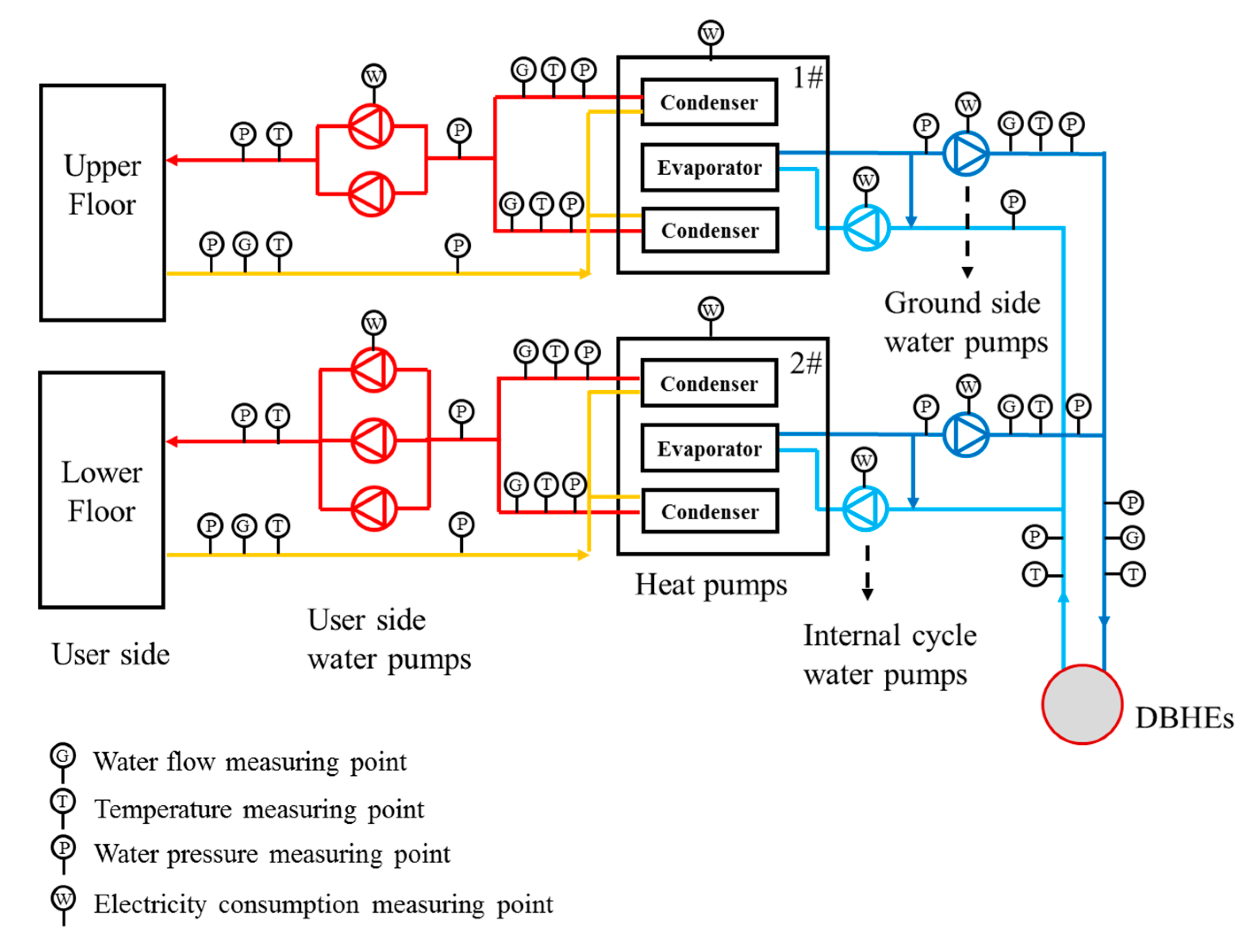
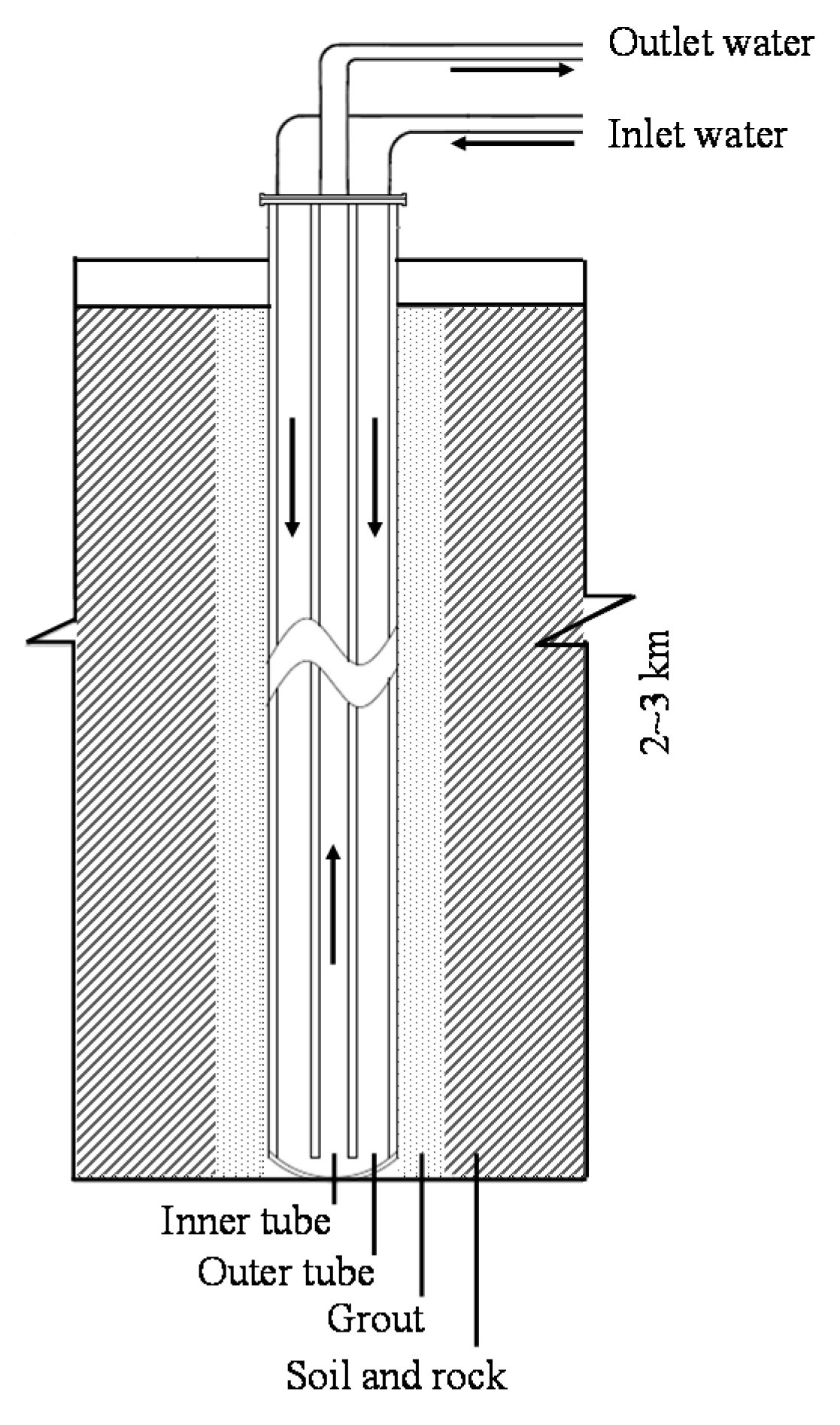








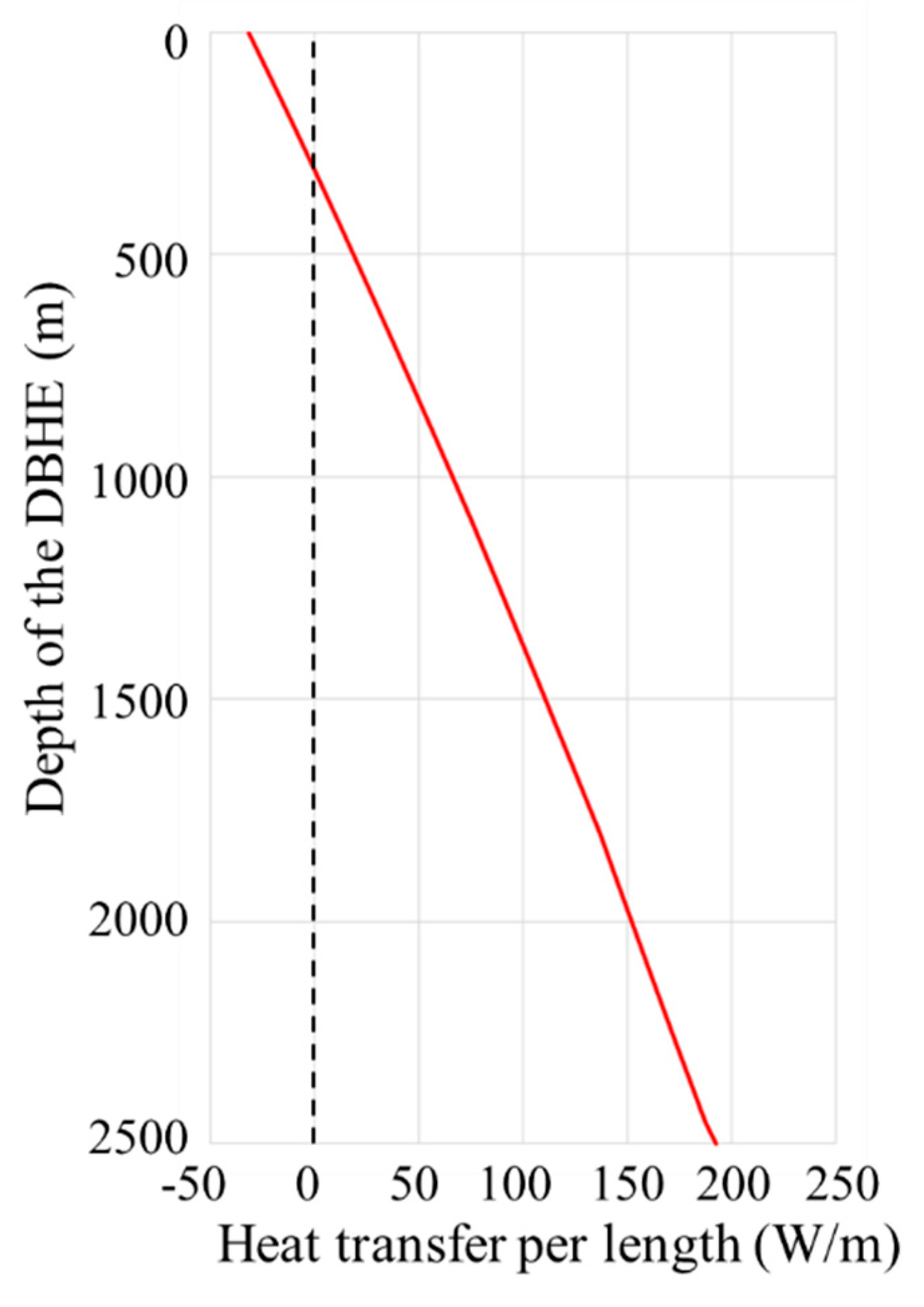




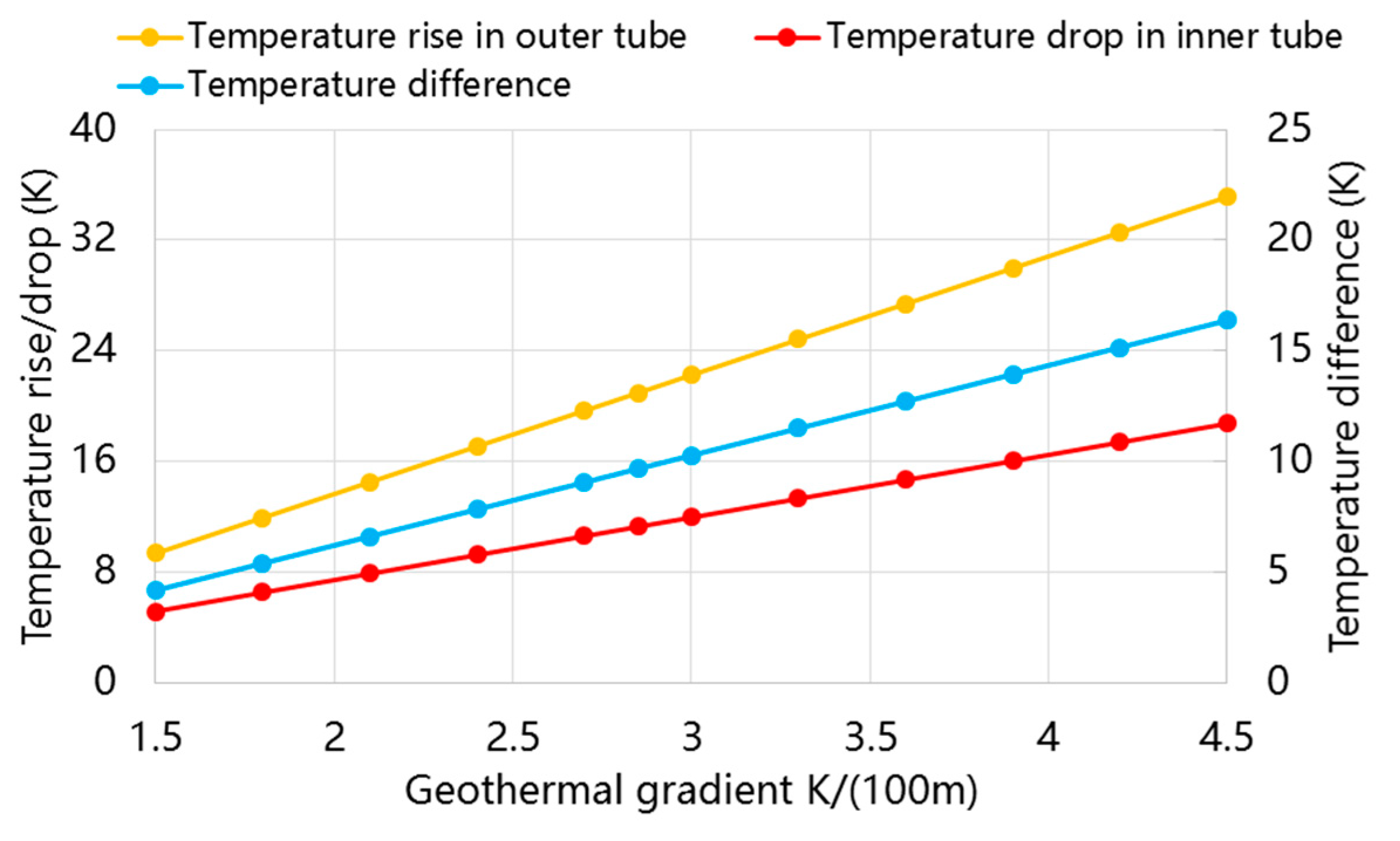



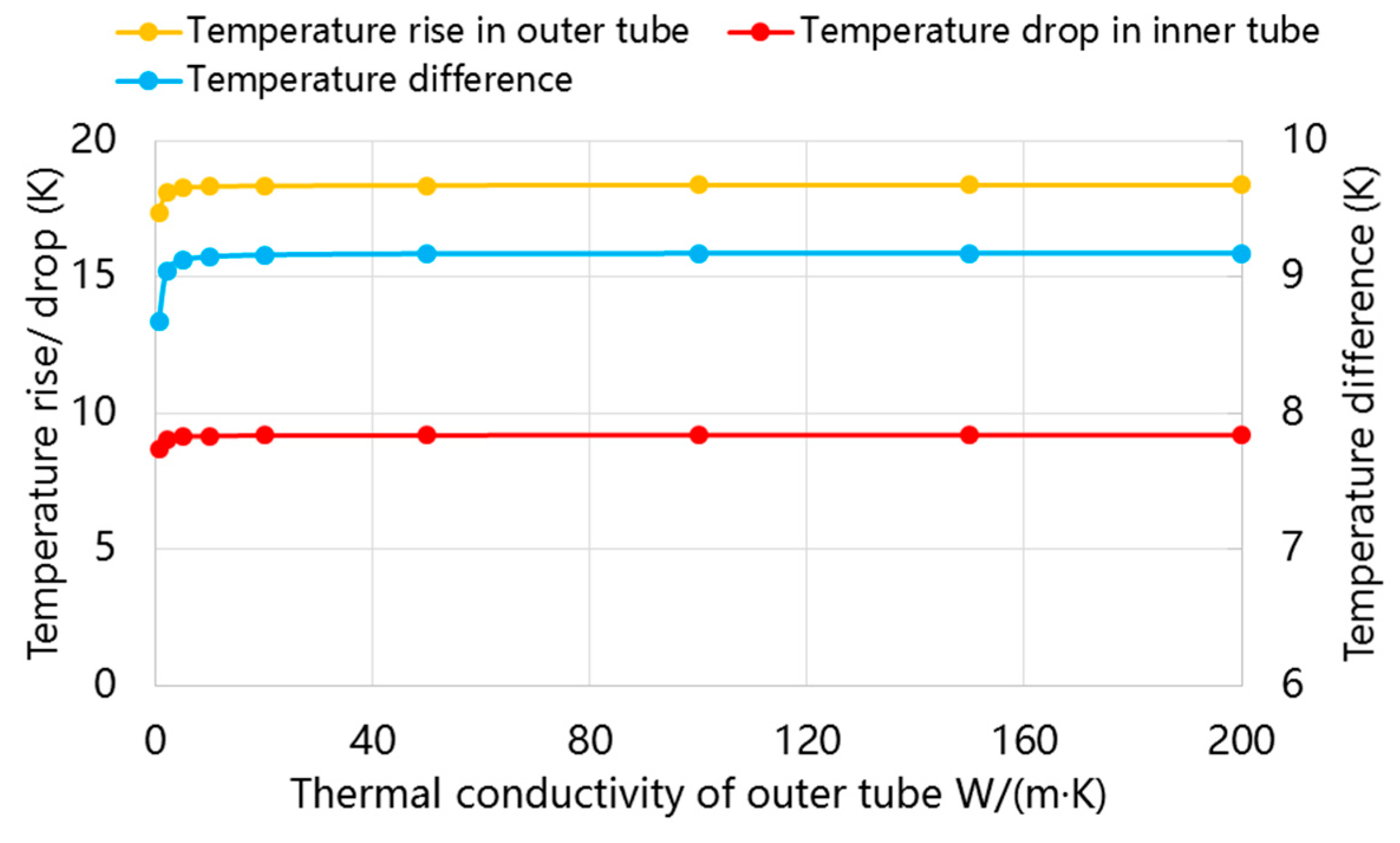



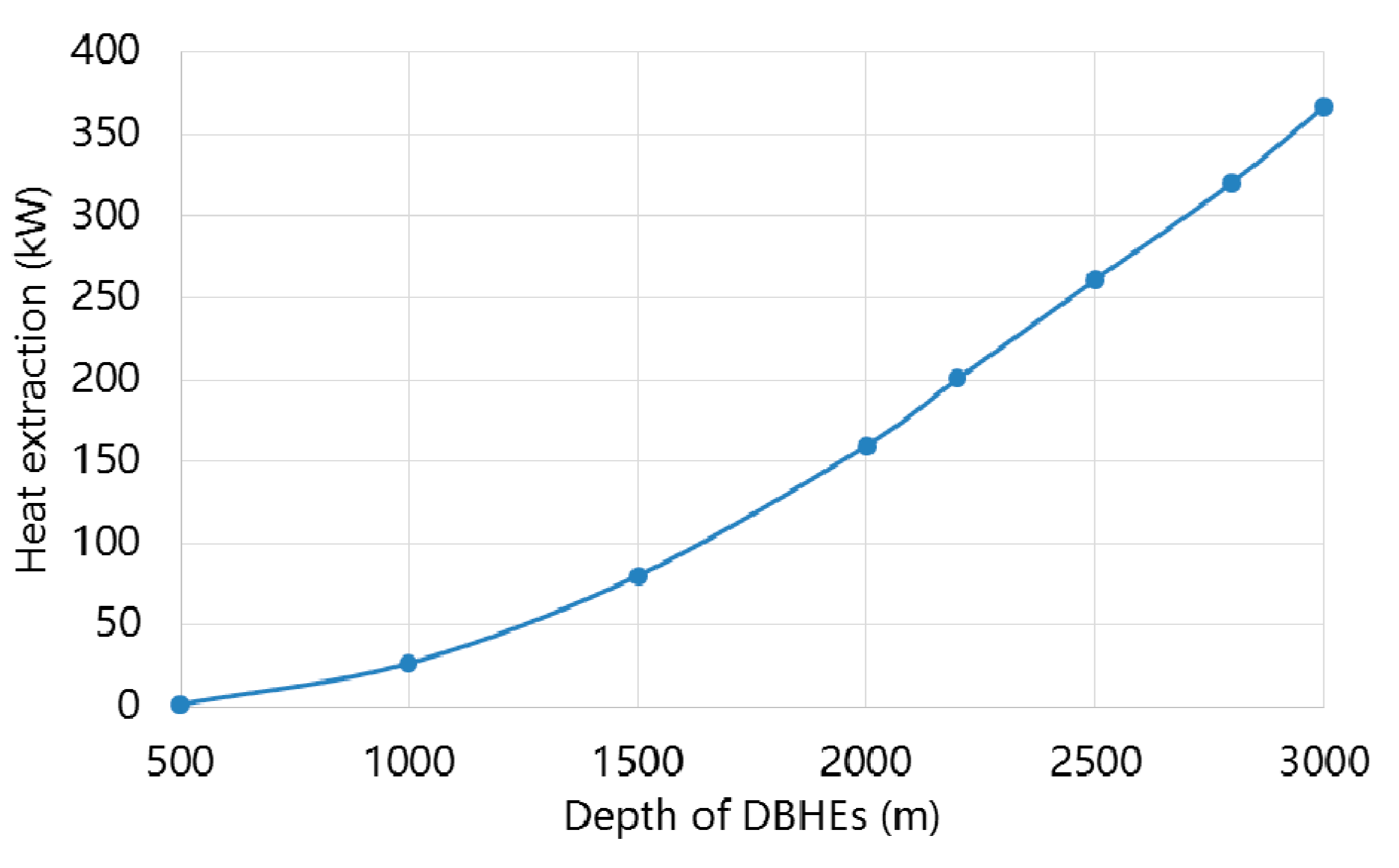





| Building Function | Residential Buildings |
|---|---|
| Designed building area (m2) | 133,400 |
| Actual heating area (m2). | 53,360 |
| Type of heat pump | Screw heat pump |
| Number of heat pumps | 2 |
| Rated heating capacity (kW) | 5680 |
| Rated COP | 5.68 |
| Number of DBHEs. | 8 |
| Depth of DBHEs (m) | 2500 |
| Designed water temperature in user side (°C) | 45/40 |
| Designed water temperature ground side (°C) | 30/20 |
| Terminal device | Radiant floor |
| Operational mode | Continuous |
| Heating season | 15th November–15st March |
| Parameters | Numerical Value |
|---|---|
| Depth of DBHE (m) | 2500 |
| Outside diameter × wall thickness (mm × mm) | 159 × 4.5 |
| Thermal conductivity of the outer pipe W/(m·K) | 54 |
| Specific heat capacity of the outer pipe kJ/(kg·K) | 0.47 |
| Density of the outer pipe kg/m3 | 7820 |
| Inside diameter × wall thickness (mm × mm) | 93 × 3.0 |
| Thermal conductivity of the inner pipe W/(m·K) | 0.18 |
| Specific heat capacity of the inner pipe kJ/(kg·K) | 2.1 |
| Density of the inner pipe kg/m3 | 930 |
| Diameter of backfill materials (mm) | 254 |
| Thermal conductivity of the backfill materials W/(m·K) | 2.0 |
| Specific heat capacity of the backfill materials kJ/(kg·K) | 0.85 |
| Density of the backfill materials kg/m3 | 2700 |
| Depth m | Geotechnical Type | Thermal Conductivity W/(m·K) | Density kg/m³ | Specific Heat Capacity J/(kg·K) |
|---|---|---|---|---|
| 0–636 | Clay | 1.8 | 1780 | 1379 |
| 636–1198 | Mudstone | 2.6 | 2030 | 1450 |
| 1198–1910 | Medium sand | 3.5 | 1510 | 1300 |
| 1910–3000 | Standstone | 5.3 | 2600 | 878 |
| Outlet Water Temperature (°C) | (m) | Outlet Water Temperature (°C) | Outlet Water Temperature (°C) | ||
|---|---|---|---|---|---|
| 1.1 | 29.714 | 1 | 29.714 | 60 | 29.714 |
| 1.2 | 29.714 | 5 | 29.714 | 600 | 29.714 |
| 1.3 | 29.716 | 10 | 29.728 | 3600 | 29.715 |
| 1.4 | 29.729 | 25 | 29.747 | 7200 | 29.741 |
| 1.5 | 29.752 | 50 | 29.786 | 18,000 | 29.832 |
| a | b | c | d | e | f | g |
| 78.78 | −0.2339 | 20.67 | 1.32×10−10 | −4.363 | −0.169 | −0.0244 |
| h | i | j | k | l | m | n |
| 0.3317 | 0.2069 | 0.4214 | −0.1989 | 2.0 ×10−7 | 2.0 × 10−5 | −0.0596 |
| Variables | Suggested Min Value | Suggested Max Value | The value Used in This Paper |
|---|---|---|---|
| (W/(m·K)) | 2.0 | 4.5 | 3.0 |
| (°C/hm) | 1.5 | 4.0 | 3.0 |
| (m) | 1000 | 3000 | 2500 |
| (kg/s) | 2.0 | 12.0 | 6.0 |
| (°C) | 5.0 | 30.0 | 20.0 |
| Conditions | Radius (m) | Radial Far Boundary Condition | Depth from Bottom of DBHE (m) | Bottom Boundary Condition |
|---|---|---|---|---|
| 1 | 100 | Isothermal condition | 200 | Isothermal condition |
| 2 | 100 | Adiabatic condition | 200 | Isothermal condition |
| 3 | 100 | Adiabatic condition | 200 | Constant heat flux |
| 4 | 30 | Isothermal condition | 200 | Constant heat flux |
| 5 | 30 | Adiabatic condition | 200 | Constant heat flux |
| 6 | 30 | Adiabatic condition | 50 | Isothermal condition |
| 7 | 30 | Adiabatic condition | 50 | Constant heat flux |
© 2020 by the authors. Licensee MDPI, Basel, Switzerland. This article is an open access article distributed under the terms and conditions of the Creative Commons Attribution (CC BY) license (http://creativecommons.org/licenses/by/4.0/).
Share and Cite
Deng, J.; Wei, Q.; He, S.; Liang, M.; Zhang, H. Simulation Analysis on the Heat Performance of Deep Borehole Heat Exchangers in Medium-Depth Geothermal Heat Pump Systems. Energies 2020, 13, 754. https://doi.org/10.3390/en13030754
Deng J, Wei Q, He S, Liang M, Zhang H. Simulation Analysis on the Heat Performance of Deep Borehole Heat Exchangers in Medium-Depth Geothermal Heat Pump Systems. Energies. 2020; 13(3):754. https://doi.org/10.3390/en13030754
Chicago/Turabian StyleDeng, Jiewen, Qingpeng Wei, Shi He, Mei Liang, and Hui Zhang. 2020. "Simulation Analysis on the Heat Performance of Deep Borehole Heat Exchangers in Medium-Depth Geothermal Heat Pump Systems" Energies 13, no. 3: 754. https://doi.org/10.3390/en13030754
APA StyleDeng, J., Wei, Q., He, S., Liang, M., & Zhang, H. (2020). Simulation Analysis on the Heat Performance of Deep Borehole Heat Exchangers in Medium-Depth Geothermal Heat Pump Systems. Energies, 13(3), 754. https://doi.org/10.3390/en13030754





